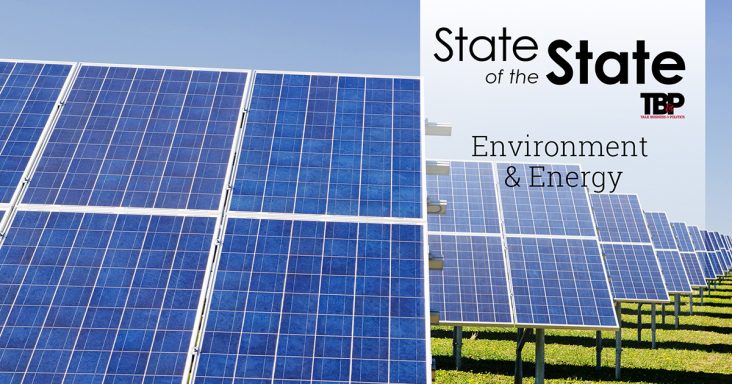State of the State 2024: Energy leaders highlight potential, pitfalls in 2024
by February 8, 2024 9:07 am 590 views

Editor’s note: The State of the State series provides reports twice a year on Arkansas’ key economic sectors. The series publishes stories to begin a year and stories in July/August to provide a broad mid-year update on the state’s economy. Link here for the State of the State page and previous stories.
This year, the energy sector is poised for growth amid opportunities to benefit Arkansas. Still, leaders are concerned that red tape and delays will stymie production and increase costs.
Lauren Waldrip, executive director of Arkansas Advanced Energy Association, said federal funding opportunities made available by the Inflation Reduction Act and Infrastructure Investment and Jobs Act provide “hundreds of billions of dollars” for which the state can compete to pay for projects.
She said the state has infrastructure needs that could be paid for with the federal money, “or those projects and upgrades will come on the backs of ratepayers.” The state needs more transmission capacity for new renewable energy projects, providing economic and environmental benefits.
“Arkansas has more projects in the transmission queue than any other state,” she said. “More transmission allows for more distributed energy, which…can be renewables, and that’s more decentralized power.”
Waldrip said distributed energy projects are alternative power sources that can lessen the strain on central infrastructure, bolster grid stability and reduce widespread outages. Streamlining the approval process for new transmission capacity will be important in connecting the projects to the grid.
“These distributed energy projects often occur in Arkansas in rural communities and make a significant impact locally, from jobs to school districts across the board, saving ratepayers money,” she said. “By building more transmission both quickly and with proper siting, we can help recognize all those benefits for communities, not just in Arkansas but across the country.”
Waldrip expects new solar projects to rise this year as the sector adjusts to a new net metering law and rules due to policy changes in 2023. The new state law changes the net metering rate structure and extends grandfathering for net metering through Sept. 30, when the 1-to-1 net metering rate structure expires.
She said the new net metering rate structure based on average wholesale rates over 12 months does not “accurately account for the true value of when that energy is produced.”
Meanwhile, consumers face rising costs resulting from litigation about utilities delaying the interconnection of arrays to the grid.
“We’ve been in a year-and-a-half lawsuit with some of the electric cooperatives who are trying to impose unauthorized requirements on their ratepayers,” she said. “We’re hopeful that, in light of the Public Service Commission’s recent rulings on some of those investigations, that will cease.”
Waldrip said 2024 goals include providing education on energy production and renewable energy projects and promoting programs that benefit Arkansas.
RISING ENERGY DEMAND
Gifford Briggs, Gulf Coast region director for the American Petroleum Institute, said the health of the energy sector “is strong. The demand for energy and oil and natural gas are only going up.”
He said U.S. production continues to rise, and the sector is producing more oil and gas with fewer emissions than in the past. “If you look at some of the projections from the Energy Information Administration and others, you see the demand is not declining. The demand is growing. We’re going to need more oil and natural gas” for years to come.
Briggs said 2023 was better than 2022 amid a transition from the COVID-19 pandemic and crisis resulting from the Russian invasion of Ukraine. The sector increased natural gas exports to support U.S. allies as Russia cut natural gas supplies to Europe.
He said 2023 ended with the U.S. Environmental Protection Agency granting Louisiana primacy over wells that allow for carbon dioxide sequestration. North Dakota and Wyoming are the only other states with primacy over these wells that store emissions underground. Primacy allows states to issue well permits without EPA approval and is expected to accelerate the permitting process.
“It’s good news for Arkansas because Arkansas in 2023 also took its first steps toward moving forward with its own carbon sequestration program,” he said.
Asked about surprises last year, Briggs pointed to the growing interest in lithium extraction in Arkansas and other states.
“You see ExxonMobil make a huge announcement in their investment into Arkansas … to do lithium extraction and mining throughout southwest Arkansas,” he said. “The need for these rare minerals like lithium for battery production for electric vehicles is growing, so we’ve seen our industry diversify and add to their traditional oil and gas portfolio. Seeing this growth in Arkansas in the lithium sector is very encouraging.”
Briggs said regulatory hurdles comprise the most significant sector challenge, including the slow permitting process. “In many cases, it takes less time to get a college degree than it does for an oil and gas permit,” he said. “That’s a significant cost to business…industry…[and] consumers, and it doesn’t have to be that way.”
He said 2023 was the first year without a completed or fully executed offshore lease sale. He noted that the new five-year lease plan has fewer lease sales than previous ones and that putting these resources off limits is counterproductive to national security and supporting U.S. allies. Briggs added that potential environmental regulations on liquefied natural gas permits would affect LNG exports, which were crucial to Europe after Russia cut natural gas supplies following its invasion of Ukraine.
“2024 is an election year,” he said. “There’s no question that energy will be on the ballot.”
